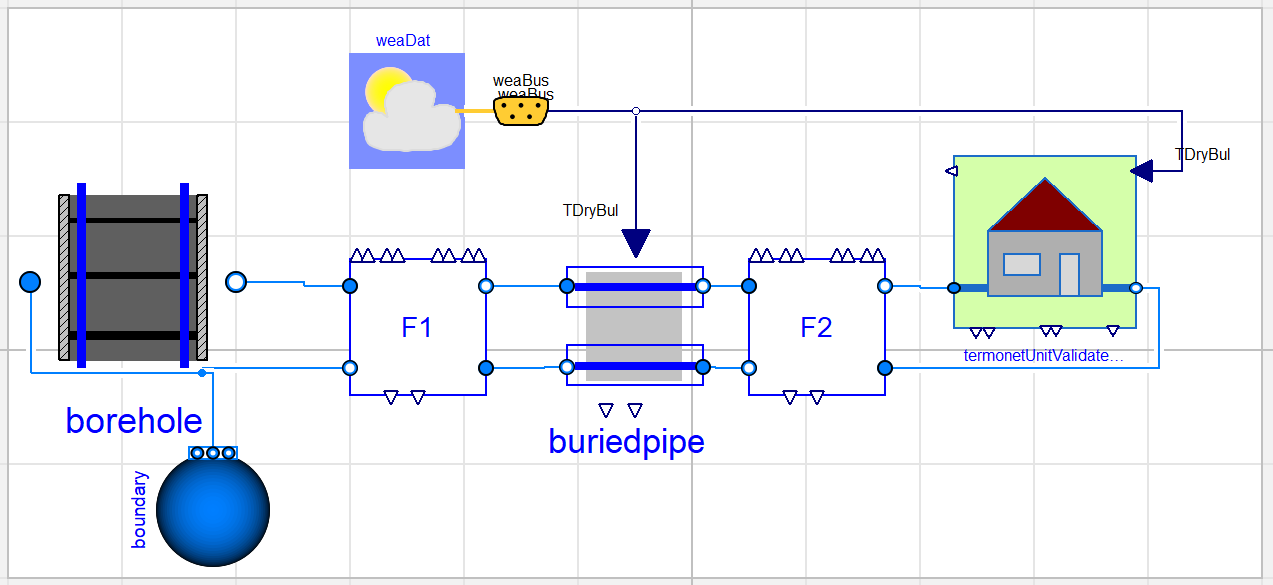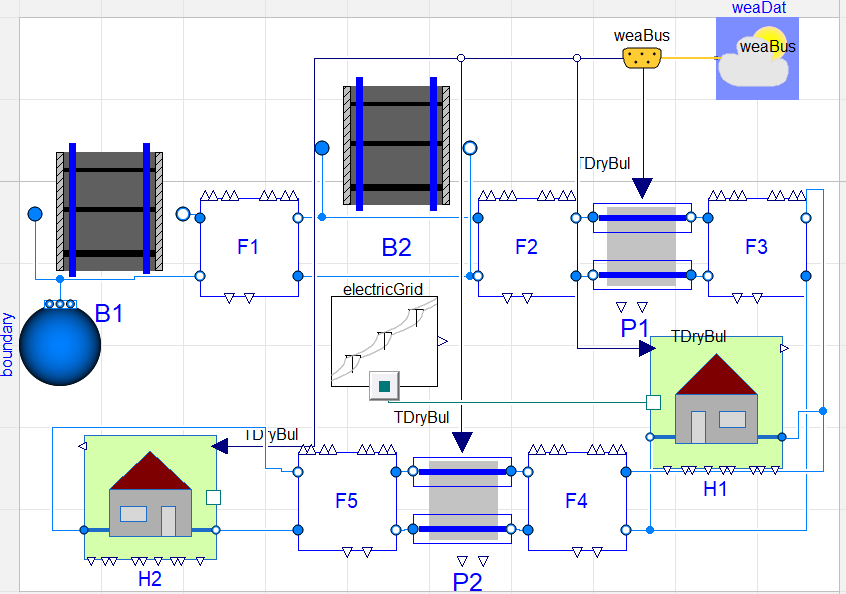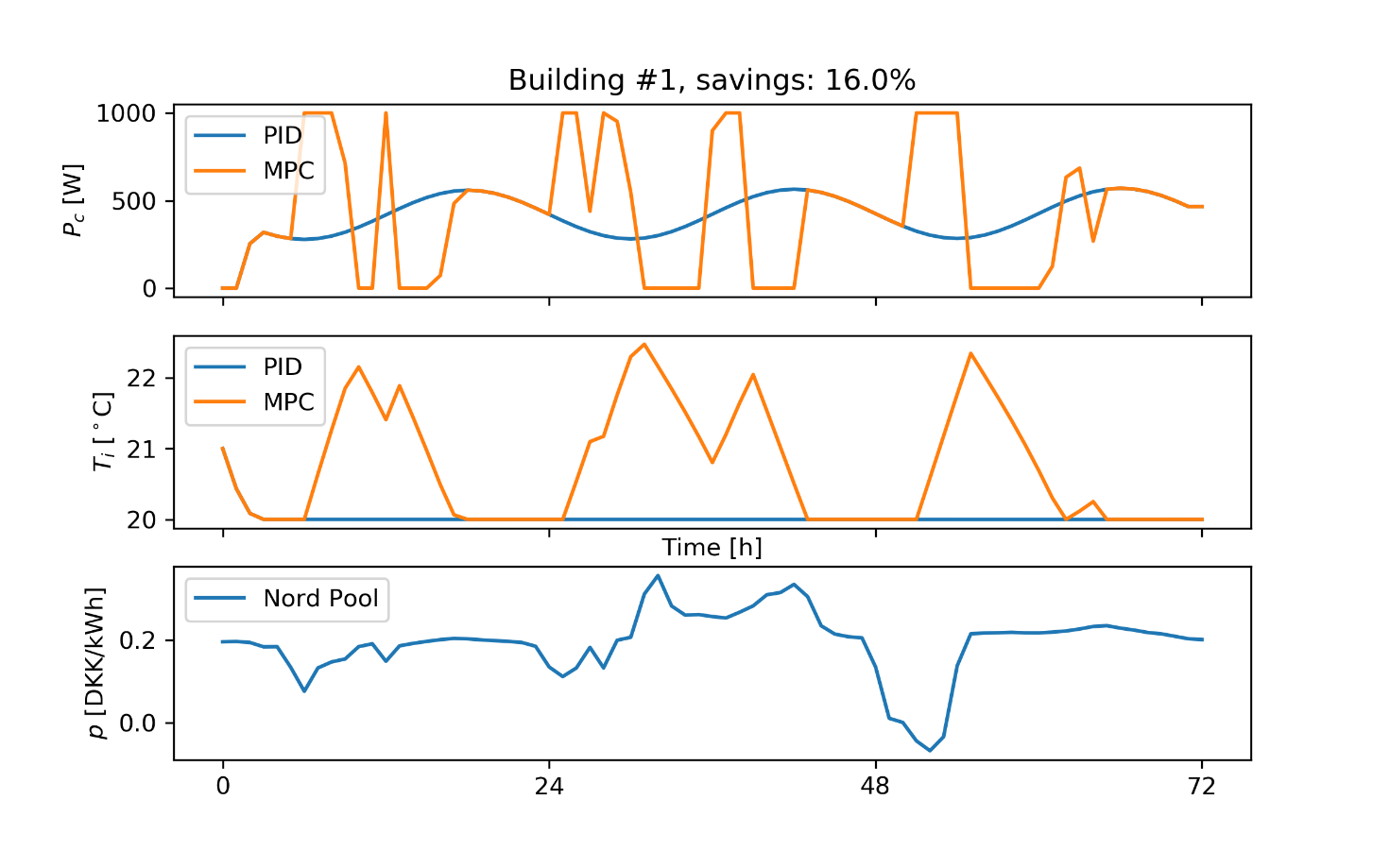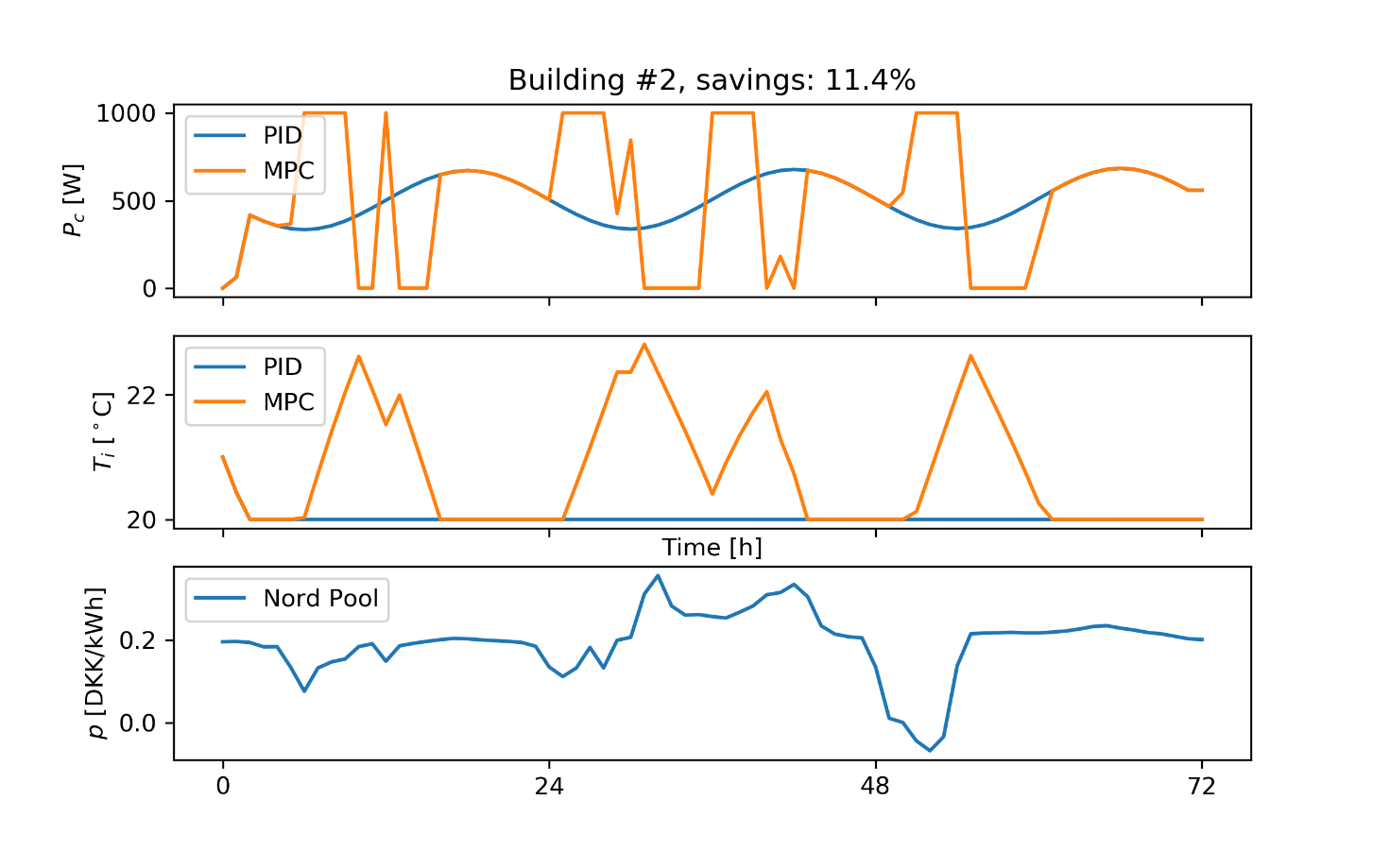MPC-oriented models of a small district with geothermal heat pumps
The recently formulated Termonet concept [1] is relevant for small number of consumers in areas where conventional district heating has not penetrated due to low consumer density. Termonet itself is a thermal network of collectively managed ground source heat pumps, connected to a thermal grid with non-insulated piping and ground-source heat exchangers [2]. The concept aims at establishing the business case for a small-scale fully sustainable district heating system.
The Termonet business case builds upon:

Fig.1 - Termonet with a single consumer

Fig.2 - Emulator model for Termonet with two consumers
Figure 3 compares the PID with varying set point (blue) and MPC strategies (red) in controlling the speeds considering the Nord Pool price minimization objective for the one of the two consumers over 72 hours in January. The top subfigure shows the power consumed by the compressor of the heat pump, which experiences large deviation from the deterministic PID curve either to higher or to lower consumption to satisfy the objective. At corresponding time periods, the indoor temperatures in the center subfigure is increased compared to the set point value maintained by the PID controller. The last subfigure shows the Nord Pool electricity price profile for the January of 2017. In this case, MPC results in 16% energy saving for the consumer and does not violet the thermal comfort constraints set by temperature values of 20 °C and 22 °C. Figure 4 shows a similar result for the second building. In this case, savings reach 11.4%.

Fig.3 - Comparison of PID control with price driven MPC for Termonet with two consumers (building 1)

Fig.4 - Comparison of PID control with price driven MPC for Termonet with two consumers (building 2)
- A borefield to completely cover heat demand of the consumers
- Non-insulated pipes to reduce initial costs
- Underground water flow to enhance energy production
- Collective control of heat pumps to minimize the total electricity price
- District heating system flexibility to shift the thermal load while maintaining the thermal comfort
- Implementation of the interaction between the electrical, thermal and hydraulic subsystems in Termonet with three consumers [3]
- Parameter estimation of Termonet variable speed pumps based on measured time-series
- Comparing Termonet with District heating (DH)
- Optimum control of Termonet consumers’ electrical input using Dymola Functional Mockup Interface
- Testing of the MPC approach for the Termonet business case
- Termonet model with a single-consumer (Fig. 1): a non-insulated pair of pipes (conductance 2.8 W/(m2K)) representing distribution network and a borehole representing heat production.
- Insulated pipe network: the copy of a single-consumer Termonet model with decreased pipe conductance of 0.032 W/(m2K).
- District heating network with a heat pump: where the production is changed from borehole to an ideal heater and the heat pump is substituted by a heat exchanger.
- Termonet emulator (Fig. 2): two boreholes two consumers and two non-insulated pipes all copied from model 1.
- Termonet control model: two simplified consumers, heat capacitor and thermal resistor representing the borefield


Figure 3 compares the PID with varying set point (blue) and MPC strategies (red) in controlling the speeds considering the Nord Pool price minimization objective for the one of the two consumers over 72 hours in January. The top subfigure shows the power consumed by the compressor of the heat pump, which experiences large deviation from the deterministic PID curve either to higher or to lower consumption to satisfy the objective. At corresponding time periods, the indoor temperatures in the center subfigure is increased compared to the set point value maintained by the PID controller. The last subfigure shows the Nord Pool electricity price profile for the January of 2017. In this case, MPC results in 16% energy saving for the consumer and does not violet the thermal comfort constraints set by temperature values of 20 °C and 22 °C. Figure 4 shows a similar result for the second building. In this case, savings reach 11.4%.


Factsheet
| Number of buildings | 3 |
| Number of thermal zones (per building) | 1 |
| Complexity of thermal zone model | Low order |
| Coupling/Decoupling between district network and buildings | Coupling |
| Simulation tool | Dymola / JModelica |
| Modelica libraries | Buildings / IDEAS / Termonet |
| Additional packages/workflows/scripts | ModestPy / MShoot |
| Simulation time | 1 year |
| Computational time | 5 min |
| Solver and tolerance | Dassl / 1e-4 |
| CPU speed | 2.8 GHz |
Authors:
Konstantin Filonenko (University of Southern Denmark - Denmark)
Tao Yang (University of Southern Denmark - Denmark)
Krzysztof Arendt (University of Southern Denmark - Denmark)
Christian Veje (University of Southern Denmark - Denmark)
Konstantin Filonenko (University of Southern Denmark - Denmark)
Tao Yang (University of Southern Denmark - Denmark)
Krzysztof Arendt (University of Southern Denmark - Denmark)
Christian Veje (University of Southern Denmark - Denmark)
References:
[1] GeoDrilling, Termonet concept, http://termonet.dk/koncept/
[2] K. Filonenko, K. Arendt, M. Jradi, S. Andersen, C. Veje, “Modeling and Simulation of a Heating Mini-Grid for a Block of Buildings,” in Proceedings of the 16th IBPSA International Conference and Exhibition Building Simulation 2019, 2020, Vol. 16.
[3] K. Filonenko, K. Arendt, C. Veje, “Modeling of thermal district heating network with common sources and decentralized heat production,” in Proceedings of the 9th International Energy Conference REMOO, 2019, article 02.013.
[1] GeoDrilling, Termonet concept, http://termonet.dk/koncept/
[2] K. Filonenko, K. Arendt, M. Jradi, S. Andersen, C. Veje, “Modeling and Simulation of a Heating Mini-Grid for a Block of Buildings,” in Proceedings of the 16th IBPSA International Conference and Exhibition Building Simulation 2019, 2020, Vol. 16.
[3] K. Filonenko, K. Arendt, C. Veje, “Modeling of thermal district heating network with common sources and decentralized heat production,” in Proceedings of the 9th International Energy Conference REMOO, 2019, article 02.013.
